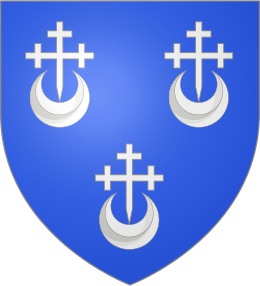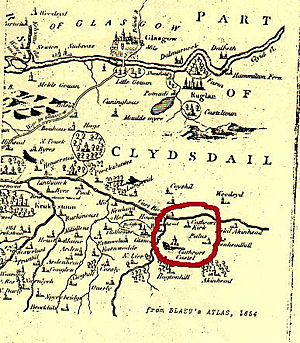Clan Cathcart facts for kids
Quick facts for kids Clan Cathcart |
|
|---|---|

Crest: A dexter hand couped above the wrist and erect Proper, grasping a crescent Argent
|
|
| Motto | I hope to speed |
| Chief | |
 |
|
| Charles Alan Andrew Cathcart | |
| the 7th Earl Cathcart | |
| Seat | Gateley Hall |
| Historic seat | Cathcart Castle |
Clan Cathcart is an old Scottish family from the Lowlands of Scotland. They have a long and interesting history, including brave knights and important leaders.
Contents
The Story of Clan Cathcart
Where Did the Clan Begin?
The Cathcart family gets its name from the lands of Cathcart. These lands are near the River Cart in Renfrewshire, Scotland. The name Caeth-cart means 'the narrow part of the Cart River'.
The first known member of the family was Rainaldus de Kethcart. He was mentioned in a document in 1178. His son, William de Kethcart, was also mentioned in documents around 1200. Later, Alan de Cathcart was part of an important land deal in 1234.
Fighting for Scotland's Freedom
William de Cathcart, son of Alan de Cathcart, was one of the Scottish nobles. He had to agree to the rule of Edward I of England in 1296.
However, William's son, Alan de Cathcart, was a strong supporter of King Robert the Bruce. He fought for Scotland's independence. Alan joined the king's brother, Edward Bruce, in a daring attack. With only fifty knights, they surprised a much larger English army in Galloway and defeated them.
Alan survived the Wars of Scottish Independence. In 1336, he made a gift to the Dominican Friars in Glasgow. He was known as Dominus Ejusdem, meaning 'of that Ilk'. Alan was also related to the Clan Bruce family through his wife.
Important Events in the 1400s and 1500s
Sir Alan de Cathcart gained many estates in Carrick. He was given the important title of Lord Cathcart in 1447. He also owned lands in Ayrshire, including the Auchencruive estate. This was the family home until 1718. Alan also became the leader of the royal Dundonald Castle. In 1485, he was put in charge of the king's cannons as 'Master of the Artillery'.
Tragically, Alan Cathcart, the son of the second Lord Cathcart, died in 1513. He was killed along with his two half-brothers, Robert and John, at the Battle of Flodden. The third Lord Cathcart also died in battle. He was killed at the Battle of Pinkie Cleugh in 1547.
Alan Cathcart, the fourth Lord Cathcart, was a Protestant. He supported the Scottish Reformation, a big change in Scotland's religion. In 1568, he and his men fought for the Regent Moray. They battled against the army of Mary, Queen of Scots at the Battle of Langside. The old Cathcart Castle has a great view of the battlefield. It is said that the queen watched the battle from there.
The 1700s and Jacobite Risings
Fighting in the 1715 Rising
Charles Cathcart, 8th Lord Cathcart was born around 1686. He had a very successful career in the army. In 1709, he became a major in the Royal Scots Greys. During the Jacobite rising of 1715, the eighth Lord Cathcart led a group of soldiers on horseback. His troops managed to outsmart the Jacobite forces at the Battle of Sheriffmuir. Before that, Cathcart had also beaten the Jacobites at the Skirmish of Dunfermline in October 1715.
The 1745 Rising and Beyond
Charles Cathcart, 9th Lord Cathcart was a helper to the Duke of Cumberland. He fought for the government at the Battle of Culloden in 1746 and was injured there. In 1768, he became an ambassador in St Petersburg, Russia. He was well-liked by Empress Catherine. He often wore a patch on his cheek. This was to hide a wound he got at the Battle of Fontenoy.
Napoleonic Wars Heroes
William Cathcart, the tenth Lord Cathcart, went to Russia with his father. When he came back to Scotland, he studied law. He became a lawyer in 1776. But when he inherited his father's title, he left law and went back to the army. He became a high-ranking general. He was also in charge of the forces in Ireland. He was made a Knight of the Thistle, a special honor.
During the Napoleonic Wars in 1807, Napoleon's army was about to take over Denmark. Lord Cathcart and Admiral Gambier successfully attacked Copenhagen. They captured Denmark's fleet of over 60 ships, along with supplies. For this success, Lord Cathcart was given new titles: Viscount Cathcart and Baron of Greenock. In June 1814, he was made Earl Cathcart.
The second Earl Cathcart also had a great military career. He fought throughout the Peninsular War. He was also at the famous Battle of Waterloo in 1815. He later became the commander of the British Army in Scotland. From 1837 to 1842, he was the governor of Edinburgh Castle.
Clan Chief
The current chief of Clan Cathcart is The Rt. Hon. Charles Alan Andrew Cathcart of Cathcart. He holds several important titles, including the 7th Earl Cathcart, Viscount Cathcart of Cathcart, Lord Cathcart, and Baron Greenock of Greenock. He is the recognized leader of the Cathcart family.
Clan Castles
- Cathcart Castle was the main home of the Earl Cathcart, who is the chief of Clan Cathcart.
- Carleton Castle
See also


